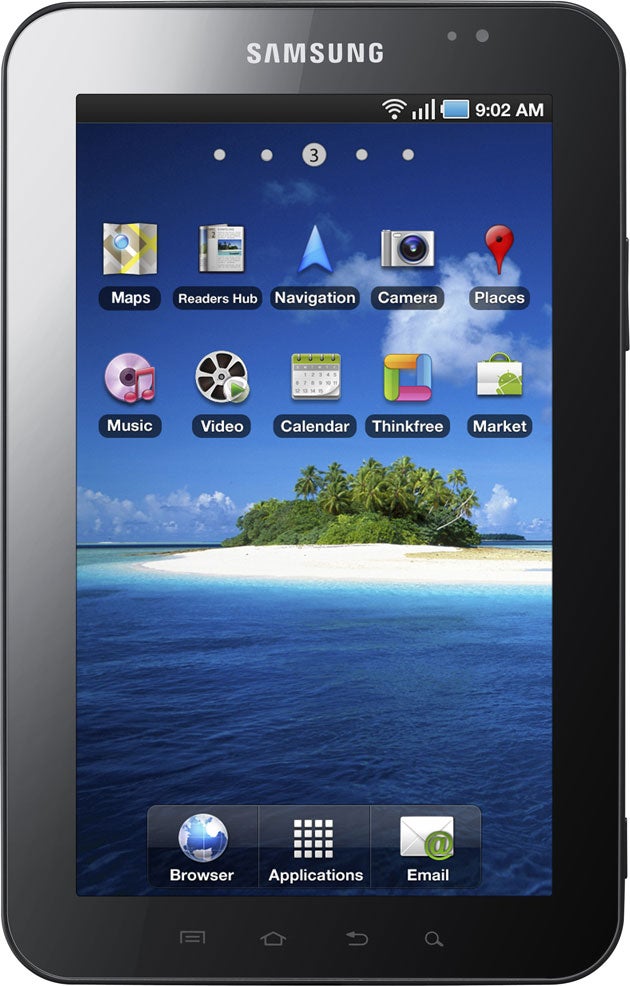Review: Samsung Galaxy Tab

Magical though it may seem, those who’ve fallen under the spell of the iPad are more aware than anyone of the fatal flaw that is its awkward dimensions. As voluminous as it is voluptuous, few pockets are sufficient to house Steve Job’s hallowed tablet. With a screen that sharp and bright, big is certainly beautiful, but it’s also... well, big.
With necessity as the mother of invention then, Samsung’s recently released alternative, the Galaxy Tab, is an attempt to fill that pocket-sized gap. At 7-inches in height, it’s the same size as the highly practical Kindle, though thicker, chunkier, and with a screen edged by a band of black shiny plastic which comprises a clear aesthetic hat-tip to its Cupertino-conceived cousin. It's weighty enough for you to feel like you’ve got your money’s worth (no mean feat given the £500 price tag), but without tiring those untrained biceps and triceps which are a depressing adjunct of western civilization’s sedentary decline.
Google’s Android operating system is well on its way to ruling the world of the smartphone having recently dispensed with the Blackberry for market share, and as well as taking strides into the world of internet-enabled television it’s branching out into the new frontier of tablet computing with perhaps more speed than haste; despite the fact that Samsung have been to the trouble of adding their graphical ‘TouchWiz 3.0’ (no sniggering at the back) layer to the OS, it’s impossible to avoid the occasional feeling that you’re just using an up-scaled Android handset.
In some situations, that’s fine; certain apps, like the un-put-downable ‘Angry Birds’, benefit greatly from the extra screen space and clearer graphics (as on the iPad, in fact). In other instances though, the tablet modifications feel depressingly half-baked, like when, for example, low power notifications refer to the device as a phone. Overall, Samsung’s modified Android experience is passable after spending a little time to get used to it, though the large icons and childish default fonts can make the experience feel like you’re a small child holding a proportionally-accurate toy version of the Galaxy S.
Features-wise there’s an adequate 3.2 megapixel camera on the back, as well as a 1.2 megapixel front-facing camera above the screen, though whether anyone who’d spend a small fortune on an Android tablet would want to look at their own, confused, face is questionable. The 1 Ghz processor means it zips along nicely even when multi-tasking, and the four front buttons, volume control and lock switch mean that those confusing moments when your iPad doesn’t do what you want it to and you’re forced to reluctantly press its single button in sad recognition of your own glaring failure as a human being (the ‘defeat button’, I call it) are a thing of the past. You can instead hit all of the buttons and make it look as if there’s some method to your madness.
Overall, the Galaxy Tab is a very nice alternative to the iPad, at a decent size and weight, with disarmingly attractive casing and all the software and hardware advantages which have propelled Android to the front of the mobile computing pack over the last three years. £500 is too much more than the Apple alternative for the addition of two cameras and an OS built on Comic Sans though, and for that reason I’d hold fire on buying an Android tablet this Christmas; perhaps until HTC decide to give this whole iPad-killer act a try, at least.
The tab is available on T-Mobile for £529 on PAYG with Pay Per Day Mobile Broadband starting from £2 per day.
Join our commenting forum
Join thought-provoking conversations, follow other Independent readers and see their replies
Comments
Bookmark popover
Removed from bookmarks